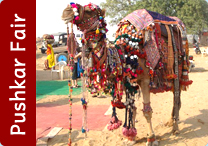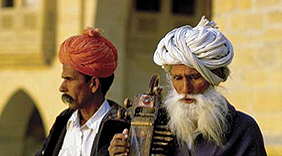
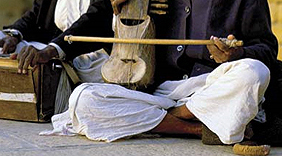

Custom Made Tour
Feel free to let us know if you are looking for customize tour program as all the tour itinerary is sample it can be modify according to your requirements.
Home - Music and Dances of Rajasthan
Music and Dances of Rajasthan
Dance with the Music of Rajasthan
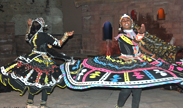
Patronized by erstwhile royalty, the music and dance of Rajasthan follows a legacy that dates back to several centuries. The rich folklore and culture has added some more sparkles to its glory making Rajasthani dance and music a treasured jewel in Indian culture. The tradition of court dances and music performance still can be seen today in the cultural mights making the grandeur of bygone Rajput era alive infront of you. Enjoy a dance performance and we can say for sure that you can't help yourself from shaking your body in the hypnotizing melody and beat.
Swinging With the Beat
Be it the mesmerizing melody of Sarangi or Shahnai or the cymbal like sound of 'manjeera' or the foot tapping beats of 'khartal' or 'dhol', when they embrace each other on the occasion of a lively dance performance, a magical ambience is created in the golden beauty of Rajasthan. The grace and beauty of the 'ghoomar', 'gair' and 'sapera ' are increased many fold with the enchanting music and song performance by the professional and folk artists. The folk songs narrate the rich folklore and imperial heritage of the state that has been captivating the entire world for many centuries. Tourists coming to Rajasthan make it a point to attend at least one dance performance while exploring the heavenly beauty of the deserts and thus collecting an unforgettable experience for the entire life.Mind blowing Skills of Dancers that Tempt
Extraordinary skill of the Rajasthani dancers may take you aback with their sheer perfection and excellence. Extraordinary performance of fire dancers may take your breath away when they dance on the bed of flaming coals swaying their body at drum beats. You will not find any blister in their feet and this shows the immense talent and perseverance they have for the sake of art. Another immensely popular dance 'Bhavai' is also well known for the unusual skill of balance when the veiled woman dancer moves at the beats with seven to nine brass pitchers over their head and standing gracefully on the edge of glass or open sword. There are some other folk dances of Rajasthan like Terah Thali and Ghumar which take the excellence of artistry to a new level of height.Decorating the Dancing Ambience
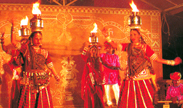
Rajasthani Dances
Rajasthan, a land of unique natural beauty has given birth to a number of spectacular dance forms which find themselves related to nature and its hues.The snake dance or fire dances seem to have come out from the nature itself whereas the hugely popular Terah Thali is a religious dance performed in front of Baba Ramdeoji. The Rajasthani dances have been fascinating the tourists coming from different parts of the world for centuries with their vibrancy without which no celebration of festival is complete.
Geendar
Geendar Dance is originally performed by the village folks of the Shekhawati region. Once the dance began, you can see number of colourful participants making a beautiful patterns, which allow delightful effects to viewers. It is a captivating dance performance, where number of participants took part, thus, perform dance in a huge circle, with the beats of drummers from a raised podium. This bewildering dance takes place in the month of march at the time of Holi festival.
Sapera Dance
Sapera Dance is the most sensuous dance, which is performed by the Kalbeliya community (Snake-charmar`s). The sapera dancers are usually tall and wear long, black skirts embroidered with the silver ribbons. As they spin in a circle, their body sways acrobatically, so that it is impossible to believe, that they are made of anything other than rubber. With the increase in the beat of tempo, the pace increases to such a pitch, that it leaves the viewer as exhausted as the dance.
Terah Taali
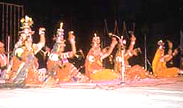
Fire Dance ( Agni Nach )
Performing fire dance is one of the most thrilling experience for must of the tourists, it is a pure devotional dance of Bikaner region, producing a mixed feeling of awe and reverence. If there is a divine protection, than the Jasnaiths of Bikaner and Churu must be responsible for cornering for the hazard of people. These dancers perform on a large bed of flaming coals, their steps moving to the beat of drums that rises in crescendo till the dancers appear to be in a near hypnotic state, most interestingly none of them get burns or blister on their feets. These devotional performances are usually to be seen late on a winter's night.
Bhavai Dance
Bhavai, one of the most popular folk dance form of Rajasthan showcases an unusual blend of balance and graceful dance movement. The veiled women dancers balance up to seven or nine brass pitchers over their head while moving their body elegantly with the drum beats and their feet settled on the top of glass or on the edge of the sword. Matka Bhavai is another dance form practiced in Bikaner where the number of vessels are gradually increased making the viewer amazed and overwhelmed.
Charee Dance
Certain ethnic groups are specially noted for the delightful dances performed by their womenfolk. One such dance is known as charee, after the name for a brass perform this dance as a gesture of welcome to an honored guest, specially the bridegroom and his party on their arrival at the bride's house. They adorn themselves with the best ornaments and colorful attire. Heavily veiled, by flaming cotton seeds on their heads and dance in gay abandon, squatting, reclining and caprioling elegantly to the flow of rhythm provided by the dholak and bankia till the flames die out.
Gair
Gair is the most beautiful dance to look at, as there are several variations to perform this picturesque dance, which is performed by both the men and women of Rajasthan. The men wear long, pleated tunics that are open out into the full-length skirts, firstly they move clockwise and then in anti-clockwise direction, with the tempo of striking sticks, so as to create the rhythm at the time of turning. It is originally a Bhil dance, which is performed at the time of Holi (festival of colours).The variations of dance is popularly known as Dandia Gair in the Marwar and Geendad in Shekhawati region.
Ghoomar
Ghoomar is an exclusive dance of Rajput womens, in which they whirl and move in a circle to the accompaniment of a kettledrum. Moving round, sometime anti-clock-wise and sometime clockwise, also gyrating at times individually, they unite hands, and with measured steps and various graceful inclinations of body, beating palms or snapping fingers at particular cadences, sing some lilting songs. With the rising tempo of the drum and the accompanying music towards the climax, participants separate themselves into pairs and swirl swiftly about their axis, their swaying colorful garments adding much to the great spectacle. A new bride, on being welcomed to the home of her husband, too is expected to dance the ghooma as one of the rituals of the new marriage. This beautiful Ghoomar dance is performed generally in the privacy of homes.
Kachchi Ghodi
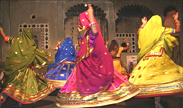
Rajasthani Music
The music of Rajasthan truly represent the myriad colour and nature of the region. Evolved from the beauty of deserts and dignity of royalty, the music of Rajasthan has been dominating the Indian music and winning hearts of people for centuries. The melody of folk songs when mingles with the sullen tune of Sarangi, the legend of courage and chivalry of the Rajputs come alive with its tales of love, betrayal and battles.One more dimension of Rajasthan music that threads both royal heritage and divinity of Lord Krishna in a perfect blend is the hummable Bhajans by Mira Bai, a queen of Rajasthan who spent her entire life making and singing Krishna Bhajans. These immensely popular songs have formed a new school of music and have reached to every Krishna lovers of the world.
Musical Instruments
ShehnaiShehnai is an slender instrument, which is thought to bring good luck, and therefore, it is widely played in Rajasthan, at the time of marriages and festivals. It consisting of a single piece wooden tube with a number of holes, and at the top it has a metal mouthpiece, through which a Shehnai can be played. You can take out number of tunes, by controlling the breath, while playing a Shehnai.
Morchang
Morchang is the most favourite instrument for Langa community of Rajasthan, a wrought iron instrument, much akin to the Jews harp, which produces twanging sounds. Held between the teeth, the left hand keeping it is position, it is played with right-hand fingers plucking the projected tongue, the sound being reinforced by air blown from the mouth of the player. The instrument is capable of producing a variety of notes and weaving a large range of rhythmic patterns.
Khartal
Khartal is considered to be a devotional instrument, which is used at the time of religious singing. It is a castanet like instrument, which consists of a pair of flat rectangular wooden clappers, having thin brass jingles attached to it. It is played by attaching a ringed into a thumb, whereas the other parts are held by the remaining four fingers, which, when clapped against each other, produce a enchanting sound. These are some of the good instruments, which reflects a great deal on the musical ingenuity of Rajasthan folks.
Chang
Chang is used as a rhythmic accompaniment to the erotic songs and dances on the colourful occasion of Holi festival. This instrument has sheep skin pasted on a large circular or octagonal wooden frame, which is balanced on the right shoulder. It is played with the help of both the hands, left striking the rim and right the central part. Interesting rhythmic patterns are woven, when the two players perform at the same time, occasionally using a stick held between their right hand fingers or using their knuckles to emphasize the beats.
Ghoongharoo
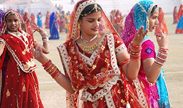
Manjeera
Manjeera is a pair of concave cymbals, cast in an alloy of brass, copper and zinc and connected to each other with a cotton cord passing through the holes in their centre. Manjeera produces a rhythmic tinkling sounds, when clanged against the tapered edges of each other. The sound of Manjeera clashing varies, depending upon the size, weight and the proportions of metals in the alloy. A virtuoso performer can produce nuances by striking at different points of one, with the rim of other. An interesting use of the instrument is made by the performers of the teratali, when as many as thirteen cymbals are put in action for the visitors.
Kamayacha
Kamayacha is an extremely elegant instrument of the professional singing community of Mangniars all over Marwar. It has a large circular belly covered with parchment, a peg system and a finger board. It has three main strings of gut, besides which, nine supplementary and other four sympathetic steel strings are placed, passing through a broad bridge. The long wooden curved bow of horse-tail hair moving on all the strings is characteristic of this unique Rajasthani instrument. Used by all singing communities, specially in Marwar but mainly by those belonging to the Langas.
Bankia
Bankia is a trumpet like brass instrument with an oblong loop type tube body, which has a saucer shaped opening and it is an integrated mouthpiece through which, an air is blown powerfully. Bankia can be played with number of instruments, but the best it is heard with the dhol. It is one of the most favourite instrument of Rajasthan at the time of auspicious and festive occasions. The sound of Bankia gives a welcome boost to the tempo of the drummer, stimulates singers, and provides refreshing fillip to the dancers. Playing Bankia is a unique instrument, which is generally used to strengthen the overall effect of the celebration.
Dhol
The Dhol is a double sided barrel drum, which is played mostly at the time of marriages and festivals seasons. The playing of Dhol is an important instrument, according to the tradition of royal Rajasthan. It is moreover like a drum, which is played by using two wooden sticks, usually made out of bamboo and cane wood. The stick used to play the bass side of the drum is a bit thicker and is bent in a quarter circular arc on the end, that strikes the Dhol, whereas the other stick is much thinner as comparison to the other one, and it is used to play the higher note end. The rope of the Dhol is usually placed over the neck of the drum player, whereas the surface of the wooden barrel of Dhol is sometimes decorated with engraved or painted patterns.
Nagara
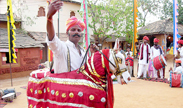
Ravanhatta
The rawanhatta consists of half a coconut shell resonator covered with membrane, bound to it with the help of cotton cords, a two feet long bamboo stick fixed to the resonator with two main strings, one of horse tail and other of steel. In addition to these are sympathetic steel strings varying between three to thirteen, passing over a bridge and than directly to the wooden pegs fixed to the sides of the stick. It is played with a curved bow of horse tail hair drawn across the strings with rhythmic jerks, the small brass bells attached to it providing the jingling stress on the beats. It is held by the left hand, the resonator resting on the left side of the chest. The dexterity lies in playing each successive note, which is clear, detached and synchronizing with singing, changing the rhythm and displacing the normal beats and accents, whenever it is required, depending upon the musical situation.


